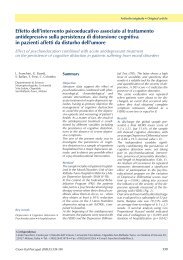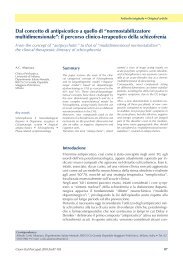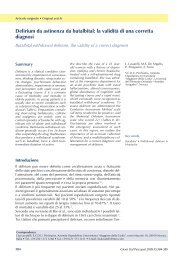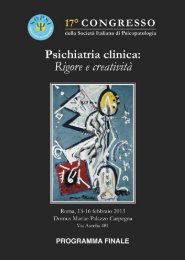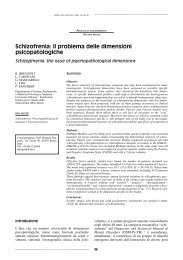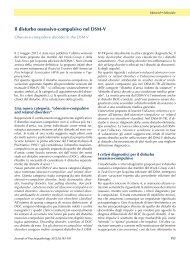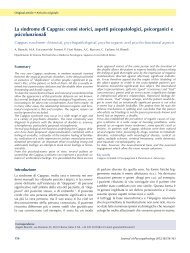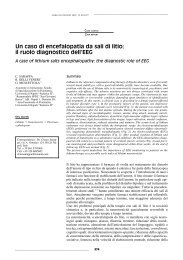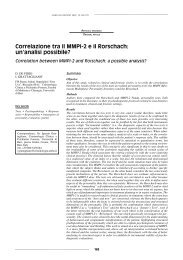XI Congresso della Società Italiana di Psicopatologia Psichiatria ...
XI Congresso della Società Italiana di Psicopatologia Psichiatria ...
XI Congresso della Società Italiana di Psicopatologia Psichiatria ...
You also want an ePaper? Increase the reach of your titles
YUMPU automatically turns print PDFs into web optimized ePapers that Google loves.
SIMPOSI TEMATICI<br />
caratteristicamente evidenziati in letteratura in pazienti con<br />
PTSD, avvalorando l’ipotesi <strong>di</strong> un appartenenza nosografia<br />
<strong>di</strong> tale <strong>di</strong>sturbo alle reazioni da stress. La presenza inoltre <strong>di</strong><br />
<strong>di</strong>fferenze <strong>di</strong> genere, analoghe a quelle riportate da alcuni<br />
autori nei pazienti con PTSD, nella sintomatologia riferita<br />
dalla popolazione <strong>di</strong> controllo, fornisce un’importante spunto<br />
<strong>di</strong> approfon<strong>di</strong>mento per l’esplorazione delle forme subsindromiche<br />
in relazione alle <strong>di</strong>fferenze <strong>di</strong> genere.<br />
23 FEBBRAIO 2005 - ORE 16.00-17.30<br />
SALA NUREYEV<br />
S47 - Attuali prospettive nel trattamento dei Disturbi<br />
<strong>della</strong> Condotta Alimentare<br />
A step-by-step cognitive-behavioural<br />
program (one day a week) for patients<br />
with obesity and binge eating <strong>di</strong>sorder<br />
J. Vanderlinden, G. Pieters, M. Probst, A. Adriaens<br />
University Center Sint-Jozef & KULeuven, Belgium<br />
A new cognitive-behavioural program for the treatment of<br />
patients with obesity and binge eating <strong>di</strong>sorder will be presented.<br />
The program runs one day a week during a 24 week<br />
period. It is aimed for both men and women with binge eating<br />
<strong>di</strong>sorder often in combination with obesity. The program<br />
consists of well structured group therapeutic sessions and<br />
focuses on the following therapeutic goals: 1) psycho education<br />
with regard to the risks of obesity and binge eating;<br />
2) increasing motivation for change; 3) learning a new and<br />
healthy eating pattern while promoting an active life style;<br />
4) becoming aware of the <strong>di</strong>fferent triggers of binge eating<br />
and learning alternatives to deal with these <strong>di</strong>fficult situations;<br />
5) installing a functional self-evaluation system; 6)<br />
improving self-esteem; 7) preventing relapse. Loss of<br />
weight is not a primary goal. The main focus is on improving<br />
the general well-being and quality of life of the patients.<br />
References<br />
1 Vandereycken W, Kog E, Vanderlinden J. The family approach to<br />
eating <strong>di</strong>sorders: assessment and treatment of anorexia nervosa<br />
and bulimia. New York/Costa Mesa: PMA Publications 1989.<br />
2 Vanderlinden J, Norré J, Vandereycken W. La Bulimia Nervosa.<br />
Guida Pratica al Trattamento. Roma: Casa E<strong>di</strong>trice Astrolabio,<br />
Ubal<strong>di</strong>ni E<strong>di</strong>tore 1995.<br />
3 Vanderlinden J, Vandereycken W. Le origine traumatiche dei Disturbi<br />
Alimentari. Roma: Astrolabio E<strong>di</strong>tore 1998.<br />
4 Vanderlinden J. Vincere l’Anoressia Nervosa. Verona: Positive<br />
Press 2001.<br />
Trattamento farmacologico integrato<br />
nei D.C.A. in co-morbi<strong>di</strong>tà con i <strong>di</strong>sturbi<br />
<strong>di</strong> personalità<br />
E. Costa<br />
Dipartimento <strong>di</strong> Scienze Psichiatriche e Me<strong>di</strong>cina Psicologica,<br />
Università <strong>di</strong> Roma “La Sapienza”<br />
L’associazione tra Disturbi <strong>di</strong> Personalità e Disturbi <strong>della</strong><br />
condotta alimentare è stata oggetto <strong>di</strong> crescente interesse da<br />
MODERATORI<br />
E. Costa, J. Vanderlinden<br />
parte <strong>di</strong> numerosi ricercatori, che in<strong>di</strong>cano una prevalenza<br />
complessiva tra questi <strong>di</strong>sturbi, compresa tra il 27% e il<br />
94%.<br />
Altri stu<strong>di</strong> tendono a privilegiare il rapporto <strong>di</strong> co-morbi<strong>di</strong>tà<br />
con i <strong>di</strong>sturbi dell’umore, e i <strong>di</strong>sturbi da uso <strong>di</strong> sostanza.<br />
Ugualmente frequente è l’associazione con i Disturbi del <strong>di</strong>scontrollo<br />
dell’impulso, associazione che ha fatto coniare il<br />
termine <strong>di</strong> Disturbo Multi-impulsivo, intendendo con questo<br />
una complessa sindrome in cui sono presenti vari aspetti <strong>di</strong><br />
<strong>di</strong>versi <strong>di</strong>sturbi <strong>di</strong> personalità, Disturbi <strong>della</strong> Condotta Alimentare<br />
ed anomalie comportamentali, sia <strong>di</strong> tipo sessuale<br />
che <strong>di</strong> tipo tossicomanico.<br />
Gli Autori analizzano, alla luce degli stu<strong>di</strong> più recenti e dei<br />
casi clinici in osservazione, i complessi rapporti tra queste<br />
con<strong>di</strong>zioni, e cercano <strong>di</strong> in<strong>di</strong>viduare un miglior approccio<br />
<strong>di</strong>agnostico e terapeutico. Dal punto <strong>di</strong> vista epidemiologico,<br />
lo stu<strong>di</strong>o dei casi in regime <strong>di</strong> degenza (127), <strong>di</strong> Day Hospital<br />
250, <strong>di</strong> Ambulatorio 479 evidenziano un aumento<br />
esponenziale <strong>di</strong> questi Disturbi, che tende ad offuscare il più<br />
noto panorama dei classici D.C.A.: anoressia e bulimia.<br />
Si sottolinea inoltre come il Disturbo <strong>di</strong> Personalità viene a<br />
costituire il motivo <strong>di</strong> fondo che fa da sintomo sottosoglia,<br />
anche nelle pause dei <strong>di</strong>sturbi principali, lungo un percorso<br />
esistenziale connotato da aspetti misti, in cui sono evidenziabili<br />
importanti componenti <strong>di</strong>saffettive e <strong>di</strong>sadattative.<br />
Il trattamento farmacologico<br />
del sovrappeso e dell’obesità<br />
F. Garonna, L. Stifani *<br />
U.O.A. <strong>Psichiatria</strong> Ospedaliera, Centro per i Disturbi del<br />
Comportamento Alimentare, Bassano del Grappa, Vicenza;<br />
* U.O.A. Emergenza, Ospedale <strong>di</strong> Adria, Rovigo<br />
L’obesità è una malattia cronica con alto tasso <strong>di</strong> mortalità<br />
ed espone a multiple e gravi patologie. Il trattamento farmacologico<br />
deve tenere in considerazione le cause <strong>della</strong> con<strong>di</strong>zione<br />
<strong>di</strong> sovrappeso e obesità, lo stato <strong>di</strong> salute del soggetto,<br />
la compatibilità con i trattamenti in atto e la in<strong>di</strong>spensabile<br />
integrazione con le misure <strong>di</strong>etetiche e il costante esercizio<br />
fisico. Attualmente gli unici farmaci approvati per il<br />
trattamento <strong>di</strong> lungo termine sono la sibutramina e l’orlistat.<br />
Una sommaria classificazione farmacologia porta a <strong>di</strong>stinguere<br />
sostanze ad azione anoressizzante <strong>di</strong> tipo noradrenergico,<br />
serotoninergico e noradrenergico/serotoninergico; so-<br />
114




